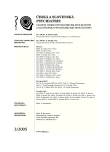-
Medical journals
- Career
Drug Abuse and Treident of Health Complications among Dancing
Authors: V. Mravčík 1; J. Valnoha 2; K. Škařupová 3
Authors‘ workplace: Národní monitorovací středisko pro drogy a drogové závislosti, Praha 1; Sdružení Podané ruce. Program Prevence zneužívání syntetických drog. Terénní programy. Brno 2; FSS MU, katedra sociologie (studentka), Brno 3
Published in: Čes. a slov. Psychiat., 101, 2005, No. 3, pp. 135-141.
Category: Original Article
Overview
The goal:
The survey mapped drug use in the dance setting and health consequences of the dancers.Method:
Participants of the dance parties who utilised preventive and harm reduction services in the dance parties provided by NGOs filled-in one page questionnaire in 2003. The questionnaire aimed at life-time prevalence and intensive (3 times and more) use in the last 30 days as well as lifetime prevalence of selected health consequences ant their causes. Frequency analysis and analysis of possible relations between health consequences and recent intensive drug use (expressed as ODDS ratio) have been carried out.Findings:
The sample consists of 468 dancers in 25 dance parties, 330 of them (70.5%) men and 138 (29.5%) women. The maximum of respondents was in the age group of 15–19 years (46.6%), the main age was 21 and 19 years for men and women respectively. Pupils, secondary school and university students for med 49.1% of the sample; 6.8% of the sample were unemployed. Lifetime prevalence of ecstasy was 90.4%, that of cannabis 91.2%, 53.0% of pervitin (methamphetamine) and other amphetamines, 7.7% of heroin, 17.5% cocaine and 51.7% hallucinogens. Ecstasy was used by 26.7%, cannabis by 55.1%, pervitin (methamhetamine) and other amphetamines by 15.6%, heroin by 1.5%, cocaine by 2.1% and hallucinogens by 8.8% of the sample three times or more in the last 30 days. One third of individuals in the sample used more then one of the selected substances three times or more frequently in the last 30 days. Individuals without any experience with ecstasy use represented 9.6% of the sample; it means that these contacted preventive and harm-reduction services even before their first ecstasy use. Health consequences related to the dance party were reported by app. 30% of respondents, app. 4% of respondents then contacted the medical service. The most frequently reported health consequences were ill-being, headache, nausea, emesis, heart palpitation and anxiety. Heat, exhaustion, excessive drug use and poly-drug use were mostly reported as reasons of the health consequences. Intensive use of ecstasy, cannabis, pervitin (methamphetamine) and other amphetamines, hallucinogens and poly-drug use have been identified as statistically significant predictive factors of party-related health consequences in the life.Conclusion:
The survey confirmed high prevalence of drug use among party dancers. Preventive and harm-reduction services on the dance setting are appropriate tool for drug use and its risks at the dance setting. The survey has shown that these services target also the users before their first ecstasy use, who are the most vulnerable group from the drug-related health risks point of view.Key words:
dance setting, dance drugs, drug use, ecstasy, MDMA, health consequences.
Labels
Addictology Paediatric psychiatry Psychiatry
Article was published inCzech and Slovak Psychiatry

2005 Issue 3-
All articles in this issue
- Drug Abuse and Treident of Health Complications among Dancing
- Economic Aspects of Daily Psychiatric Care I. Randomization Procedure, Sociodemographic and Clinical Characteristics
- Economic Aspects of Daily Psychiatric Care II. Comparison of Patients in Daily Care and Classical Hospitalization
- Structure and Function of the Nerve Cell Membrane
- Mental Features as an Initial Manifestation of Glioma
- The Drug Scene and Security Services
- Czech and Slovak Psychiatry
- Journal archive
- Current issue
- Online only
- About the journal
Most read in this issue- Mental Features as an Initial Manifestation of Glioma
- Drug Abuse and Treident of Health Complications among Dancing
- Structure and Function of the Nerve Cell Membrane
- Economic Aspects of Daily Psychiatric Care I. Randomization Procedure, Sociodemographic and Clinical Characteristics
Login#ADS_BOTTOM_SCRIPTS#Forgotten passwordEnter the email address that you registered with. We will send you instructions on how to set a new password.
- Career

